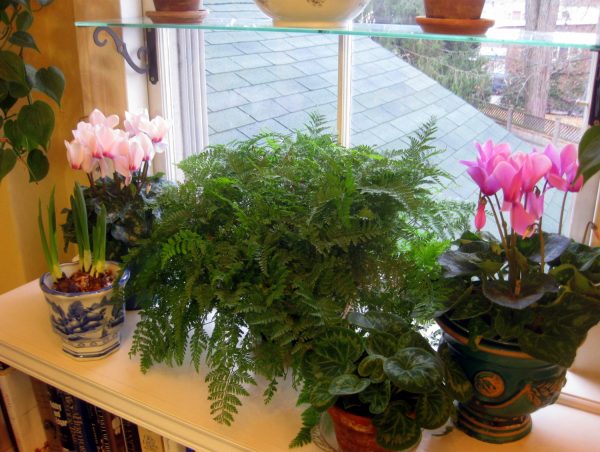

Keeping balanced humidity level in your house, which is not too low and not too high, is a very important thing. The importance of proper humidity level is not only about how uncomfortable it is staying in too humid or too dry environment but is also about some more serious problems.
One of those is the fact that high level of humidity can cause several health problems. This can even be a trigger of allergy symptoms.
Can you believe it? All this time if you may seem to experience some allergy symptoms like coughing and sneezing this may not because anything else but the very high level of humidity in your house, which can also make the number of germs and bacteria in there increasing significantly.
Table of Contents
- When in Every Year Does Humidity Level Get too High?
- How to Reduce Humidity in House in Summer
- How to Remove Moisture from Air
- What Is Dehumidifier?
- How a Dehumidifier Works
- Why Dehumidifier Is a Bad Solution?
- Indoor Plants as Natural Dehumidifier
- What Are the Benefits of Dehumidifying Plants?
- Who Can Use Dehumidifying Plants in Their House?
- The Top 5 Dehumidifying Plants to Pick
- Where to Place Plants as Natural Dehumidifier?
As experienced by so many people already, indoor environment that is too humid is also bad for furniture. In some cases this may even cause damage to electronics.
When you realize that your room or even most rooms in your house are too humid, you may wonder about how to deal with the problem. If that is really so, this post is the one you are looking for.
Here we will discuss completely about a way to deal with humid indoor environment. The special thing is that the topic will be limited more on how to remove humidity from a room without a dehumidifier. Interesting isn’t it?
When in Every Year Does Humidity Level Get too High?
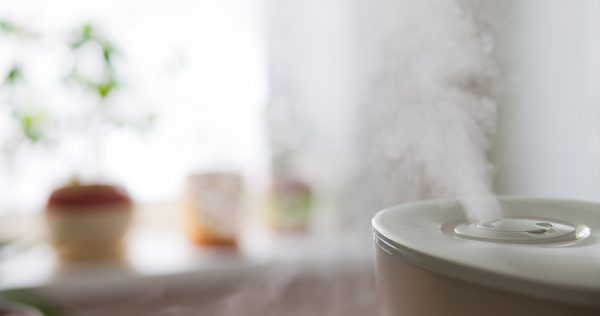
via alexwalter.com
Higher level of humidity is something we can meet every year commonly, except in area with extremely humid where the level of humidity is generally high almost all the time. Many people think that in every year, the time when humidity level in houses gets too high in only in winter. Is it right?
The fact that you need to know is that actually residential humidity level commonly gets higher in every year not only during winter season. He same condition is very possible to find during summer time too.
This can be even more surprising to you because as a matter of fact the level of humidity during summer time is higher than the humidity in winter time.
For this especially, there is a scientific explanation that can make everything clearer. The culprit is none other but the high temperature in summer. It makes the air reacts naturally by holding more moisture resulting to the higher level of humidity.
How to Reduce Humidity in House in Summer
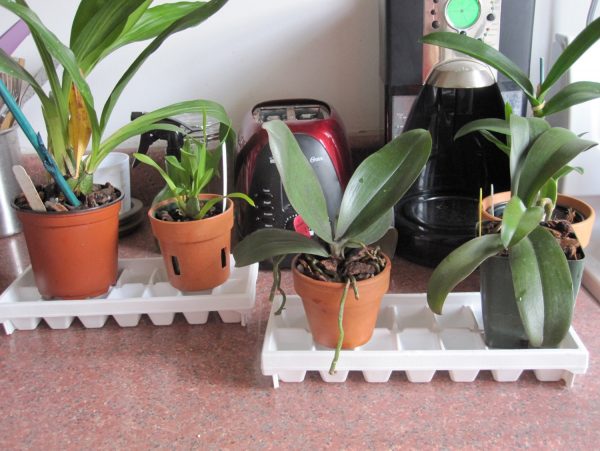
via pinterest.com
As told in the previous part, summer humidity is higher than humidity in winter. The situation is worse because the humidity is combined with hot weather too.
This is definitely the main reason why people, including you, feel a greater discomfort when facing summer humidity instead of facing winter humidity. The discomfort is not only found outside but also inside the house. You may even find it very difficult to sleep in summer nights because of the same reason.
Thankfully, there are quite a lot of practical ways you can do in dealing with humidity in indoor environment during summer time.
For example, you can avoid opening curtains during day time so it will reduce the amount of heat entering the house.
If you worry about too dark interior because most curtains are closed at day, if the curtains are made from thick material, you can replace those with sheer curtains, especially the ones with bright color since such color can reflect heat instead of absorbing it.
If you want to open all windows in your house at day because you think this can make the indoor cooler because of the air flow, it seems you need to rethink the decision.
Opening all windows during summer day might not be a good decision because some windows may face a direction where a lot of sunlight comes from. The best solution is opening only windows in shaded area so less heat will come into your house.
Using electrical fan especially when you need to stay in indoor environment in a hot day can also be a good solution. The reason is because the fan will move the air around your body and this is good since it will make the sweat on your body evaporate better.
For you to know, one of the reasons why you feel so uncomfortable when the weather is hot is because the air is too moist that the environment becomes humid and it is harder for sweat to evaporate to the air.
For a comfortable sleep in summer night, you can try to open the window of your bedroom an hour before you go to sleep. This simple solution will let fresh breeze in to the room and it will be much easier for you to get better quality sleep.
A thing you need to remember when you want to try the previous solution is to close the window again after you think the room already gets enough breezes or else you will need to deal with the possibilities for summer insects, including mosquitos, to enter the room.
If you think opening the window all night long is a much better since you simply cannot stand the heat and humidity, you can consider window screen to avoid mosquitos coming in.
How to Remove Moisture from Air
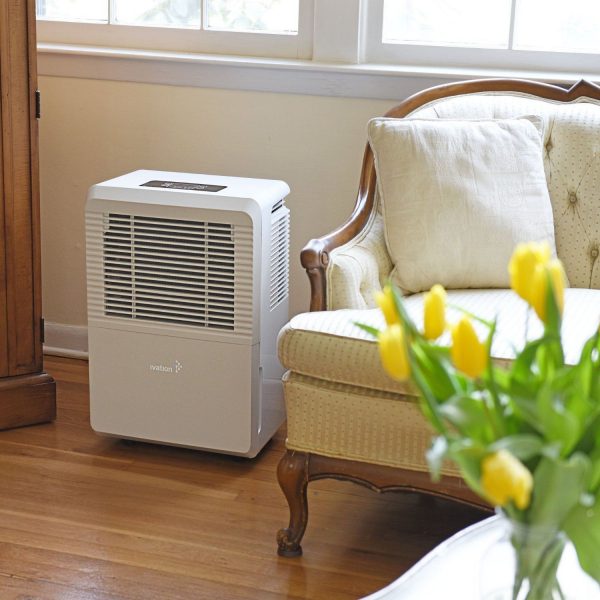
via amazon.com
The main idea about reducing humidity in your house is about removing moisture from air. The natural ways told in the earlier part can be effective actually.
However, maybe sometimes you just want another solution that is simpler and does not need too much effort. In this situation, of course you can always use dehumidifier to deal with high humidity during summer time as well as during winter time or the time in any other season.
What is it actually? Is it really the best solution for dehumidifying? Let us find out in the next parts of this post.
What Is Dehumidifier?

via dehumidifierportal.com
Dehumidifier can simply be described as an electrical hardware that can be used to reduce the high level of humidity in indoor environment can balance it.
Commonly, there are 4 major elements in a dehumidifier. Those are;
- Fan compressor
- Cooling coils
- Heater
- Reservoir or water container
How a Dehumidifier Works
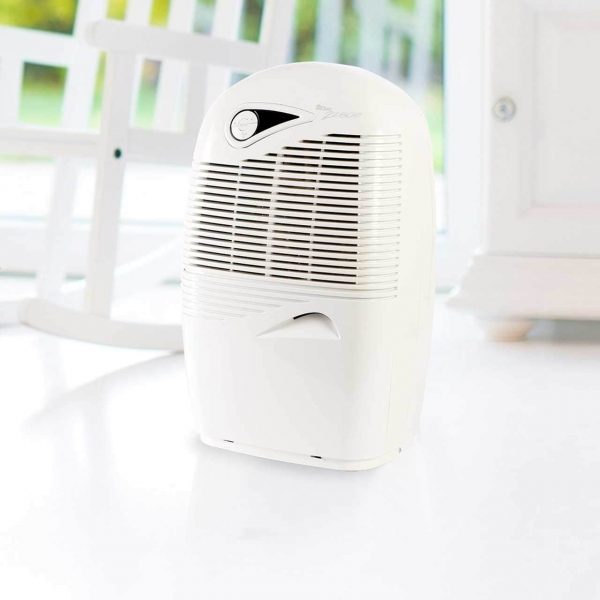
via ao.com
If you ask about how it works, it is by removing moisture from air. The very simple explanation about the step by step of how it works can be seen below.
- First of all, the moist and warm air in a room is sucked in by the dehumidifier by using the fan compressor.
- Then, inside the dehumidifier, the air will pass through the cooling coils, which function is actually removing moisture from the air for the sake of gaining air with lower level of humidity. The way is by cooling the warm air down.
- Before being blown out to the indoor environment again, the less humid air will pass through a heater which function is to reheat the air to its original temperature. From this, you will know that a dehumidifier is not always function as cooler to the air.
- Lastly, the air will be returned to the indoor environment where it is sucked from while the extra moisture will be collected in the reservoir in the form of water.
Why Dehumidifier Is a Bad Solution?
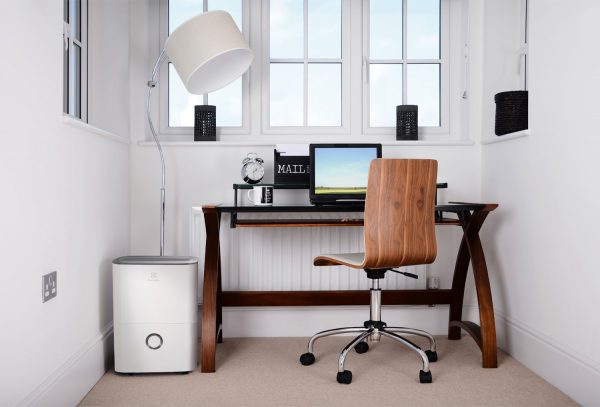
via newsroom.electrolux.com
Using dehumidifier to reduce the very high level of humidity in your house sounds to be a very interesting idea. By using this product, you can get a more comfortable home condition very easily and quickly too.
The big question about this that you should really think about in your mind is; Is it true that dehumidifier is the best solution to pick in dealing with the situation? Unfortunately, the answer is NO.
It is true that right now there are so many dehumidifier products sold at hardware stores that it will never be hard for you to get one to use at home.
The fact is not that simple because most of the time people will need more than just one dehumidifier if they really want to make the whole house comfortable during the low humidity period. It means there is a quite big chance for you to spend a large amount of money in purchasing all dehumidifiers you need.
The large amount of cost of using dehumidifier does not stop right there. Once you decide to use dehumidifiers in our house, it is very possible for your electricity bills to rise up significantly.
The cause of this is none other but the fact that the all dehumidifiers will commonly be turned on for a quite long time every day. Can you imagine how much money you need to prepare to pay the monthly bills because of the use of those products and also the use of other electronics in your house?
Indoor Plants as Natural Dehumidifier

via pinterest.com
Instead of using dehumidifiers and make your electricity bill rise up to the sky, there is a much better solution you can take into consideration. It is using indoor plants as natural dehumidifier other than using electrical dehumidifier you can find at stores.
In this world, there are a lot of plants that are famous because of their dehumidifying ability. Commonly, these plants can act as dehumidifier because they basically get most water they need from the air in the environment they are placed in instead of through the roots.
It is very reasonable then if these plants are also famous because of their ability to absorb moisture from air and are often used as natural dehumidifier. Surely, these plants are the answer of the question about how to remove humidity from a room without a dehumidifier.
What Are the Benefits of Dehumidifying Plants?

via foliageconcepts.wordpress.com
If seen from the benefits, surely there are a lot of things that make dehumidifying plants to be a much better choice to pick than electrical dehumidifier. Do you want to know what the benefits are? Here is the list.
-
- Natural
Natural is obviously the very first benefit can be obtained from dehumidifying plants. It means, as dehumidifier, the plants are environmental-friendly and give no harm to nature.
-
- Cost-Friendly
The next benefit of the plants is cost-friendly. These plants will never makes your electrical bills extremely high since they do not need any electricity to perform the dehumidifying function.
It cannot be denied that you may still need to use some amount of money in caring the plant. Although so, the money needed for this is not much.
As long as you can provide enough amount of sunlight for the plants to grow indoor, water the plants regularly, fertilize the plants every once in a while, there will be no other things needed basically.
-
- Decorative
The last most significant benefit of dehumidifying plants is that they are decorative. While performing the dehumidifying functions, the plants can also decorate your home interior in a natural way. Some of the plants are also known to have flowers so the decorative value is even higher.
Who Can Use Dehumidifying Plants in Their House?

via atap.co
This question may sound simple but this is often asked by many people. Who can use dehumidifying plants in their house?
Basically, everyone can use the plants as dehumidifier, including also you. Even so, it cannot be denied that there are some requirements to be fulfilled.
For example, those people should have a house that can let natural sunlight to come in through windows, glass walls, glass doors, etc. With those, there is no need to take the plants outside once in while in order to fulfill the need of light to grow.
Taking care of dehumidifying plants is not a hard thing to do even for those who are busy. Although so, no matter how busy you are you should never forget to water the plants regularly and fertilize the soil once in a while. For the watering, you can make daily watering schedule in approximately the same time every day.
As for the fertilizing, you can make a note and stick it on your fridge door or somewhere else that is easy for you to see so you will never forget to re-fertilize the plants, which is usually done once in a year.
The last but not least, dehumidifying plants are simply perfect to use by people whose house is too humid.as a matter of fact, they are actually the people who need the plants the most. It is especially if they do not really want to use electrical dehumidifier.
The Top 5 Dehumidifying Plants to Pick
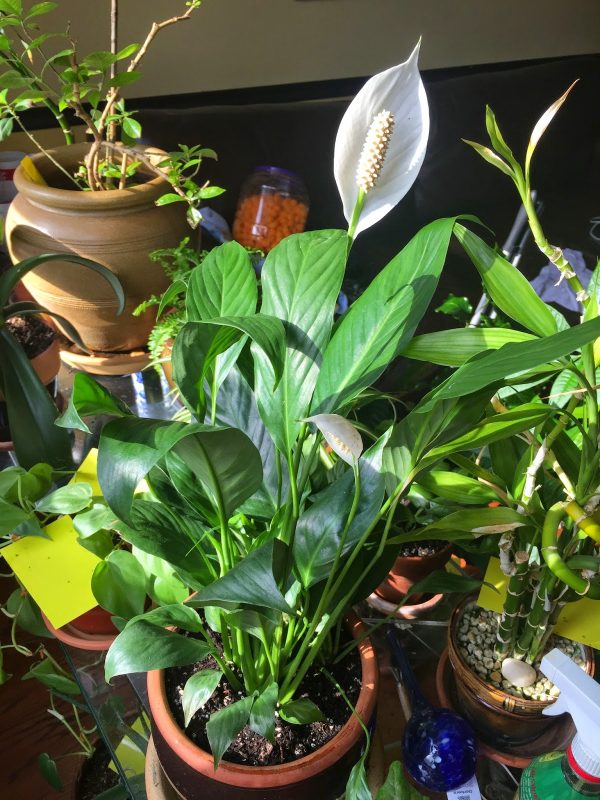
via indoorgardener.org
From all indoor plants with the ability to reduce humidity inside your room specifically and in your house generally, there are 5 top options that are about suggested to you in this post. Those plants are listed in the following.
-
- Boston Fern

via indigoandhoney.com
Commonly, Boston Fern grows healthily in areas with moist climates. It is very reasonable then if this plant naturally has the ability to absorb humidity too. The same dehumidifying ability also functions well when this plant is kept as indoor houseplant.
It is even better because it is proven to balance different levels of humidity in indoor area so planting this in your house create a chance in creating a more comfortable home interior.
Caring Tips: Boston Fern can grow well in your house since it does not really need direct sunlight to be healthy. Indirect sunlight, especially in medium level, is enough for it to grow and serve you the dehumidifying function.
For the watering, you just need to remember not overwatering the plant. Soil with even moisture is enough for it.
An important thing to remember when keeping Boston Fern indoor is applied in winter months.
In those months the air may dry out a bit more than the in the other months. Because of this, you can keep the plant away from perishing by misting it.
-
- English Ivy
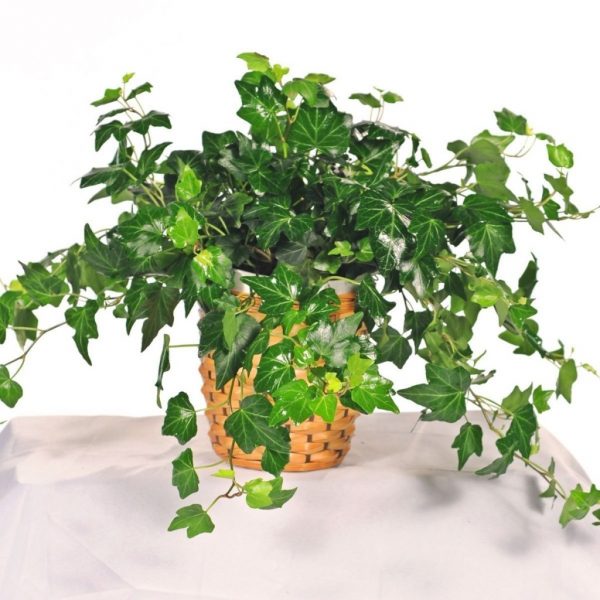
via theboredmind.com
Compared to other indoor plants, English Ivy can be said to offer more benefits when it is functioned as natural dehumidifier in your house. The first benefit is that it is a perfect dehumidifying plant to hang, which also means that the plant can remove humidity in higher location.
The plant is also found to be more beneficial because it does not only able to remove humidity but also a product of room’s high humidity, which are airborne molds.
Caring Tips: For you to know, English Ivy plant does not need too much sunlight so keeping indoor is simply perfect. For a healthier growth, you just need to make sure that the soil is evenly moist.
-
- Peace Lily
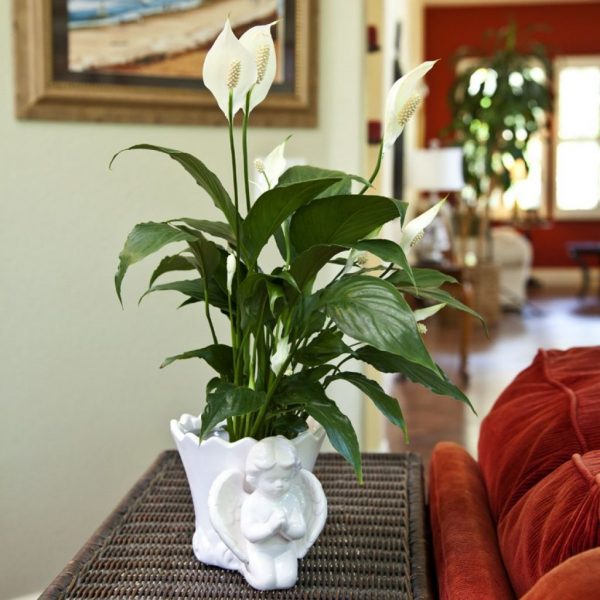
via pinterest.com
Peace Lily is well-known by its great ability to absorb moisture from the air of the environment in which it is placed through the leaves. This is obviously the reason why the plant is a perfect selection for dehumidifying.
This plant is an even better choice to take into consideration because it does not only able to dehumidify. This is also able to purify the indoor air of your room too. It means the plant can clean the air from some types of bad contaminants.
Caring Tips: Peace Lily does need too much sunlight for growing. Even only a little sunlight is enough for this plant.
Since this plant naturally absorb moisture through the leaves, it does not need too much watering or else it will just perish.
An interesting fact you need to know about this plant it that it is mildly toxic when consumed. This is the reason why placement of this plant must be considered properly. It is better to place it in location that is not easy for children or pets to reach.
-
- Reed Palm

via pinterest.com
Just like any other plant types, Reed Palm is also perfect solution for indoor area with high level of humidity. This plant usually lives in tropical area where the air is not only warm but also humid. Its natural ability is absorbing moisture from air through leaves.
Just like Peace Lily, Reed Palm also has air purification function. So, besides dehumidifying air in your home interior this can purify the air too.
Caring Tips: A little amount of light is enough for the plant. In order to help the plant thrives, you can try to keep the soil when it grows moist.
-
- Tillandsia

via soulintraining.wordpress.com
The special thing about Tillandsia is that is can survive by only absorbing moisture through its leaves. Because of this, you do not need to worry that your indoor area will become more humid since it absorbs moisture instead of releasing it.
Caring Tips: While Tillandsia only needs a medium amount of sunlight to grow, you need to know that watering is important for it. At least in every week you need to water the plant two up to three times for best growing.
Where to Place Plants as Natural Dehumidifier?
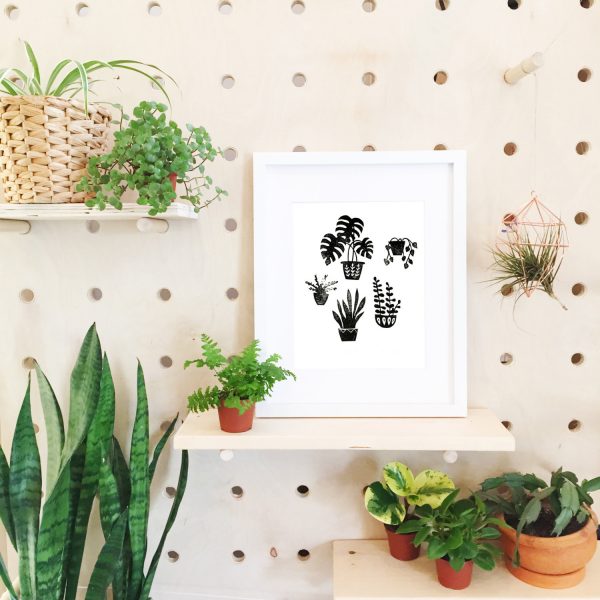
via etsy.com
When you already know about how to remove humidity from a room without a dehumidifier, which is by using natural indoor plants, now you need to know about the best places to place the plants in your house for best dehumidifying as well as growing. In the following are some ideas you can try at home.
-
- Boston Fern on Table
Placing potted Boston Fern on table as you can see in the picture is a simple but good idea than placing the plant on floor.
The reason is because higher position like this will make the dehumidifying function performs better in the indoor environment. It can be said so because it will be easier for the plant to catch and absorb moisture from the humid room.
-
- English Ivy on Shelf
As told in the previous part about English Ivy, placing this plant in higher location is best in removing moisture from the whole room. The problem is; what if you cannot find anything for the potted English Ivy to hang on to? What is shown in the picture can be the solution to that problem.
-
- Peace Lily
When thinking about how to place Peace Lily in your room as a natural dehumidifier, you should also think about its beauty advantage that is located in the white flowers. If you are agree with this idea, an inspiration to place container small Peace Lily on living room like this is worth trying, right?
-
- Reed Palm
Reed Palm can grow quite tall. Therefore placing it on table or on any higher location is not really a good idea since this will only reduce its aesthetic value. The best choice for this dehumidifying plant is to place it on floor as seen in the picture.
-
- Tillandsia
The most popular way of placing Tillandsia in home interior is by making terrarium out of it. Instead of letting the plant to dehumidify your room, you can significantly increase the beauty value of the room interior if terrarium is the one you choose.



